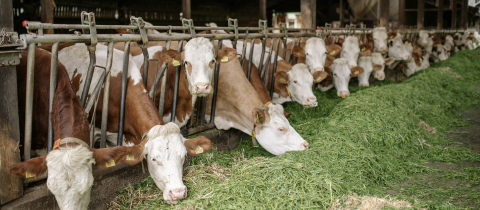The second part of the question is easy to answer. “Saltpetre,” (the term refers either to potassium or sodium nitrate) has no effect on carnal urges. The story that this chemical was put into soldiers’ food to decrease their sex drive is a total myth.
Now on to the more serious aspects of saltpeter. One of the most deadly substances known to mankind is produced by Clostridium botulinum bacteria. Seven million times more toxic than cobra venom, “botulin” poisons its victims by blocking the action of the neurotransmitter, acetylcholine. Symptoms can range from double vision and difficulty in swallowing to paralysis and death. The spores of this organism lurk in many foods and under the right conditions (lack of oxygen and low acidity), become active and liberate their toxin. Sausages are the classic example of the type of food that can be affected, and the word "botulism" in fact derives from the Latin "botulus," meaning sausage.
Luckily, botulism can be prevented by the appropriate use of sodium nitrite, a discovery that actually came about in an accidental fashion. Salting of meat is an ancient method of preservation based upon the ability of sodium chloride to kill bacteria by drawing out much of their water content. About five hundred years ago, some clever cook noted that the effectiveness of salt in preserving meat depended on its source. Furthermore, salt that worked particularly well also improved the meat’s flavor and color. The secret turned out to be an impurity, potassium nitrate, more familiar to us as “saltpeter.” Actually, the real secret isn’t even nitrate, it is nitrite. Some bacteria in meat are resistant to salt and have the ability to convert nitrates into nitrites. As soon as this was discovered, food processors realized that it was more efficient to use sodium nitrite directly as a preservative. Actually, the situation is even a bit more complicated chemically, because the true active ingredient isn’t nitrite, but its decomposition product, nitric oxide. It is this substance that produces the characteristic color of cured meats and destroys the bacteria that can cause botulism. But there is some worry that bacteria are not all that nitrites destroy. Our health may also suffer as a result of excessive exposure.
Concern about the relatively small amounts of nitrites used as food additives began in the 1960's when researchers noted that domestic animals fed fish meal preserved with nitrites were dying of liver failure. The problem was traced to a group of compounds called nitrosamines, which formed by a chemical reaction between the naturally occurring amines in the fish and sodium nitrite. Nitrosamines are potent cancer causing agents and their potential presence in human foods became an immediate worry. An examination of a wide variety of foods treated with nitrites revealed that nitrosamines could indeed form under certain conditions. Fried bacon, especially when "done to a crisp," consistently showed the presence of these compounds. So did hot dogs. And to our great horror, beer was also contaminated! How was this happening?
In the case of meat, there was no great mystery. When proteins break down during cooking they can yield amines which in turn react with nitrites to form nitrosamines. The beer issue took a bit of investigating before the problem was traced to the flame drying of malt. When air is heated, its nitrogen and oxygen components can react to form various nitrogen oxides which in turn can react with amines in the malt to produce nitrosamines. Much to their relief, brewers were able to alter the process and prevent direct contact of malt with flame. No need to worry about nitrosamines in beer now!
Curbing nitrosamine formation in cured meats turned out to be more of a challenge. But it was met. Ascorbic acid (Vitamin C), or its close relative, erythorbic acid, can be added by manufacturers to curb the reaction of nitric oxide with amines. These compounds also enhance the preservative effects of nitrite by promoting its conversion to nitric oxide, allowing for less nitrite to be used. In recent years the nitrite levels in foods have been continuously reduced to the point where most products now contain less than 100 parts per million, and result in minimal nitrosamine formation within the food.
A further concern, though, is the possible formation of nitrosamines within the human body. We ingest both nitrites and amines in our food, and the possibility exists that these can combine to form carcinogenic substances under the acidic conditions found in the stomach. Some epidemiological studies suggest this is more than a theoretical possibility. A recent Swedish investigation found that eating more than 3 servings of processed meats a week was associated with a significant increase in stomach cancer when compared with consuming less than 1.5 servings a week.







